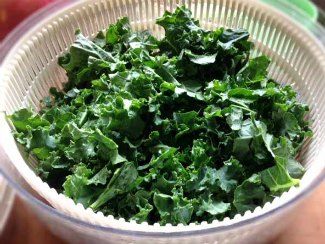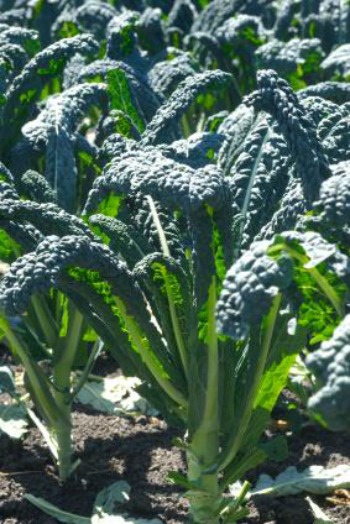Article by Dr. Linda Posch MS SLP ND
Check What’s Cooking America’s delicious Kale Recipes for some delicious and great kale cooking ideas.
When you mention kale, the majority responds with raised eyebrows and mumble “Huh”? “What’s that”? Kale is an old, hardly noticed and powerful green food. Kale is a leafy green vegetable with a mild earthy flavor. The ideal season for kale is between mid winter and early spring where it can be found in abundance in most produce sections of local grocery stores. However, kale usually is available year round. Righteously so, kale is starting to garner well deserved attention among dieticians and other health care professionals. This is due to its natural and nutrient rich phytochemical content which brandish unparalleled health promoting benefits. Kale is a nutritional powerhouse.
Kale is overflowing with essential nutrients such as calcium, lutein, iron, and Vitamins A, C, and K. Kale has seven times the beta-carotene of broccoli and ten times more lutein. Kale is rich in chlorophyll and provides much needed fiber so lacking in the daily diet of processed food eating Americans.
The “Icing on the Kale” are the naturally occurring photochemicals sulforaphanes and indoles which research suggests may protect against cancer. Let’s not forget the essential antioxidant Vitamin E. Rest assured kale spares nothing in providing one with the required nutrients coupled with associated health benefits. This is not a shy leafy green by any means and certainly will assist one in achieving an alkaline body balance.
 The naturally rich sulfur content of kale deserves a bit more discussion. Researchers have discovered that sulforaphane helps boost the body’s detoxification enzymes, potentially by altering gene expression. This is turn is purported to help clear carcinogenic substances in a relatively timely manner. Sulforaphane is formed when cruciferous vegetables such as kale are chopped or chewed. This triggers the liver to produce natural enzymes which function to detoxify cancer causing chemicals, to which we all are exposed on a daily basis. A relatively new study published in the Journal of Nutrition (2004) demonstrates that sulforaphane helps stop breast cancer cell proliferation. Kale should be considered a regular part of the diet, especially for the ladies.
The naturally rich sulfur content of kale deserves a bit more discussion. Researchers have discovered that sulforaphane helps boost the body’s detoxification enzymes, potentially by altering gene expression. This is turn is purported to help clear carcinogenic substances in a relatively timely manner. Sulforaphane is formed when cruciferous vegetables such as kale are chopped or chewed. This triggers the liver to produce natural enzymes which function to detoxify cancer causing chemicals, to which we all are exposed on a daily basis. A relatively new study published in the Journal of Nutrition (2004) demonstrates that sulforaphane helps stop breast cancer cell proliferation. Kale should be considered a regular part of the diet, especially for the ladies.
Kale descends from the wild cabbage which originated in Asia. Kale is thought to have been introduced to Europe by the Celtics where it remained a staple. Kale was an important food item early in European history and a crop staple in ancient Rome. Kale was eventually introduced to the USA during the 17th century by early English settlers. Unfortunately, we typically see kale used as decoration or garnishes for side dishes and salad bars. Once here twice forgotten, give kale the special attention it deserves. Your body is guaranteed to thank you.
A leafy green vegetable starting to gain widespread attention, kale belongs to the Brassica family, a group that also includes cabbage, collard greens, and Brussels sprouts. Choose kale with small leaves as they will be tender and offer a slightly sweeter taste. Make kale leaves a regular addition to your salads. A sauteed side dish of kale, onions, and garlic drizzled in olive oil is second to none. If you are an avid juicer, you already appreciate the natural liquid vitamin content in plenty of green foods. By all means juice up the kale. One of nature’s best liquid vitamin drinks has never tasted so good.

